BUSN20017: Analyzing Intercultural Communication Challenges Report
VerifiedAdded on 2023/06/07
|18
|5320
|186
Report
AI Summary
This report explores the significance of effective intercultural communication in international business, focusing on the challenges faced by BeautyPro in its Chinese operations. It analyzes issues stemming from different cultural values and etiquette, direct versus indirect communication styles, and varying cultural norms in decision-making. The report emphasizes how these differences can lead to conflicts and hinder organizational performance. It further discusses the importance of understanding cultural dimensions like individualism vs. collectivism and power distance. Recommendations are provided to address these challenges and enhance intercultural communication within the organization. Desklib provides a platform for students to access past papers and solved assignments for further study and research.
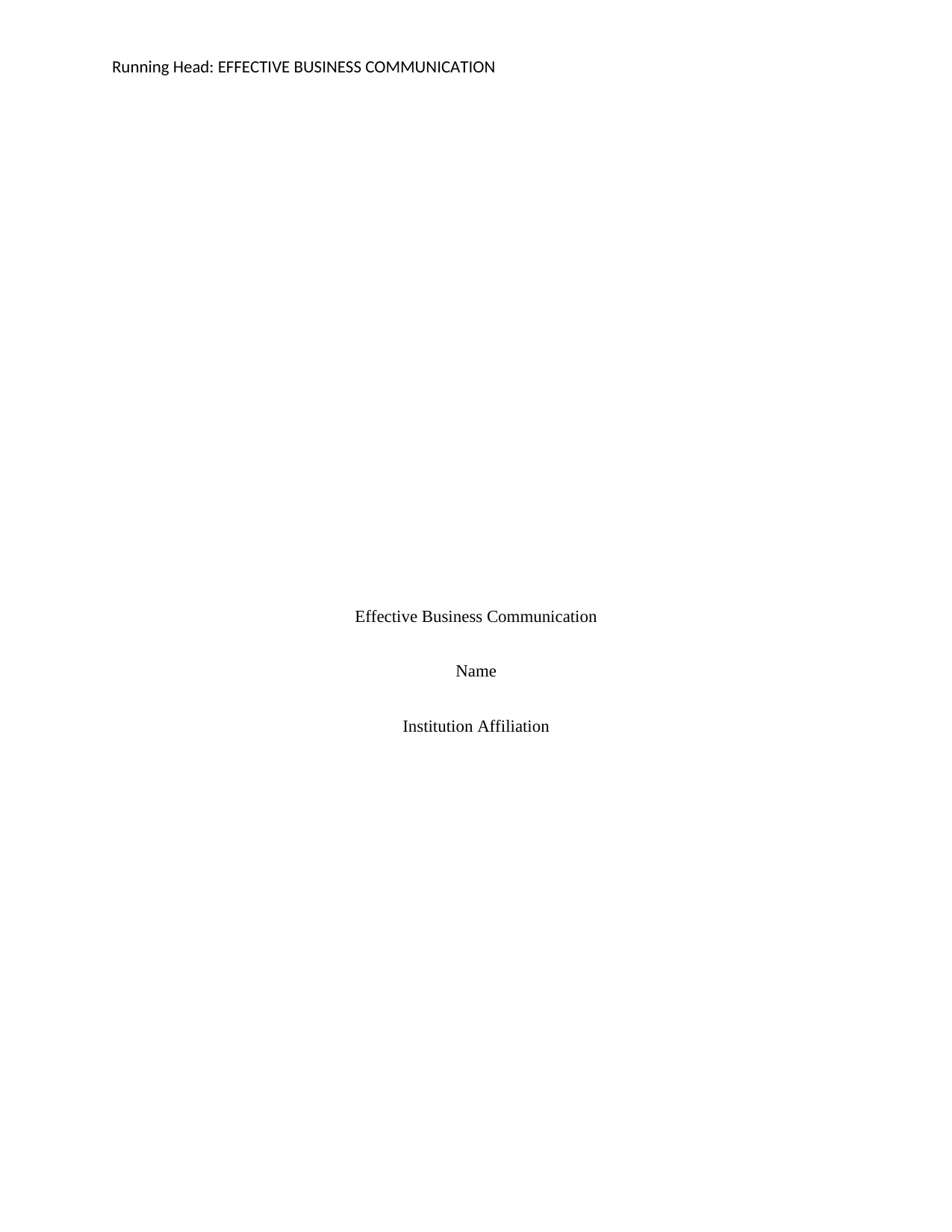
Running Head: EFFECTIVE BUSINESS COMMUNICATION
Effective Business Communication
Name
Institution Affiliation
Effective Business Communication
Name
Institution Affiliation
Paraphrase This Document
Need a fresh take? Get an instant paraphrase of this document with our AI Paraphraser
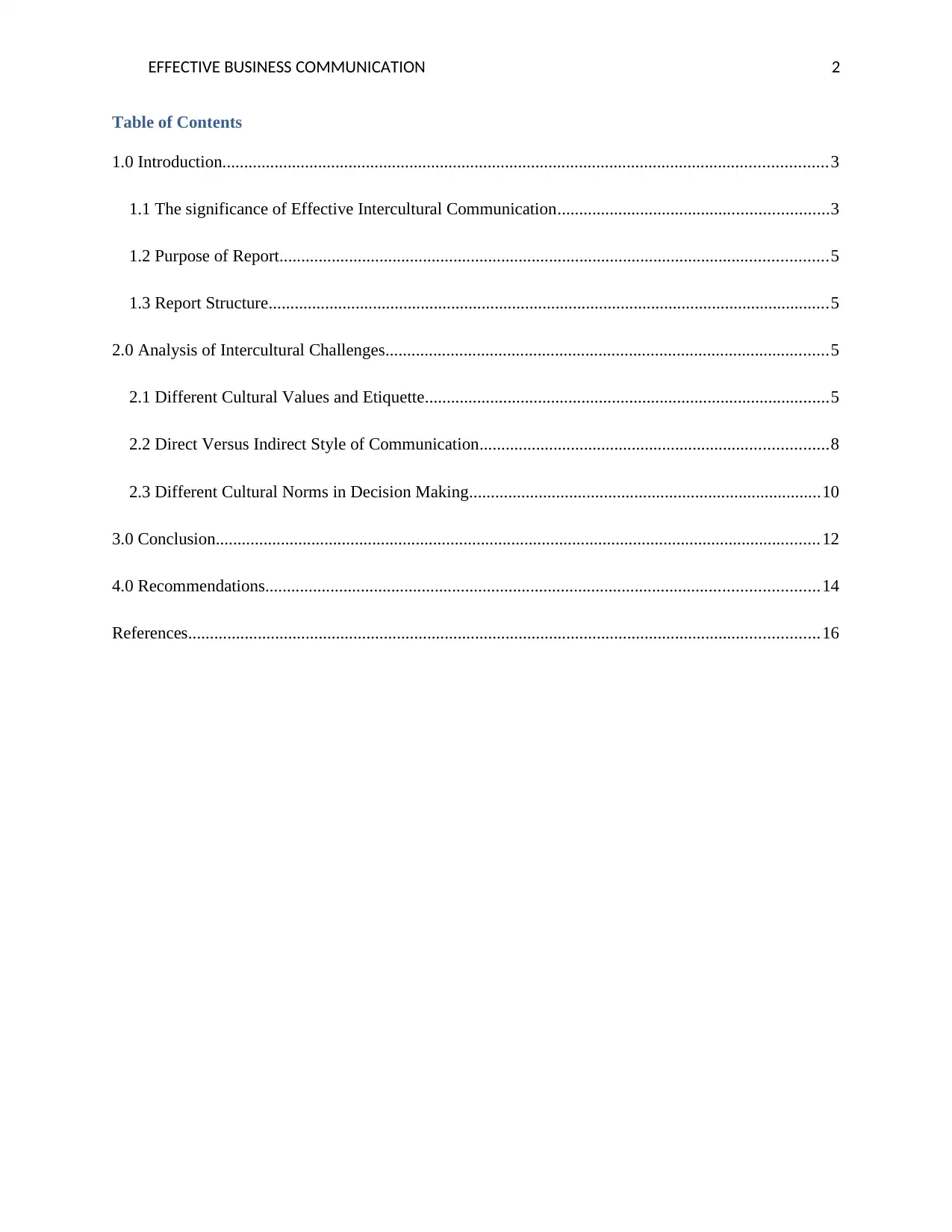
EFFECTIVE BUSINESS COMMUNICATION 2
Table of Contents
1.0 Introduction...........................................................................................................................................3
1.1 The significance of Effective Intercultural Communication..............................................................3
1.2 Purpose of Report..............................................................................................................................5
1.3 Report Structure.................................................................................................................................5
2.0 Analysis of Intercultural Challenges......................................................................................................5
2.1 Different Cultural Values and Etiquette.............................................................................................5
2.2 Direct Versus Indirect Style of Communication................................................................................8
2.3 Different Cultural Norms in Decision Making.................................................................................10
3.0 Conclusion...........................................................................................................................................12
4.0 Recommendations...............................................................................................................................14
References.................................................................................................................................................16
Table of Contents
1.0 Introduction...........................................................................................................................................3
1.1 The significance of Effective Intercultural Communication..............................................................3
1.2 Purpose of Report..............................................................................................................................5
1.3 Report Structure.................................................................................................................................5
2.0 Analysis of Intercultural Challenges......................................................................................................5
2.1 Different Cultural Values and Etiquette.............................................................................................5
2.2 Direct Versus Indirect Style of Communication................................................................................8
2.3 Different Cultural Norms in Decision Making.................................................................................10
3.0 Conclusion...........................................................................................................................................12
4.0 Recommendations...............................................................................................................................14
References.................................................................................................................................................16
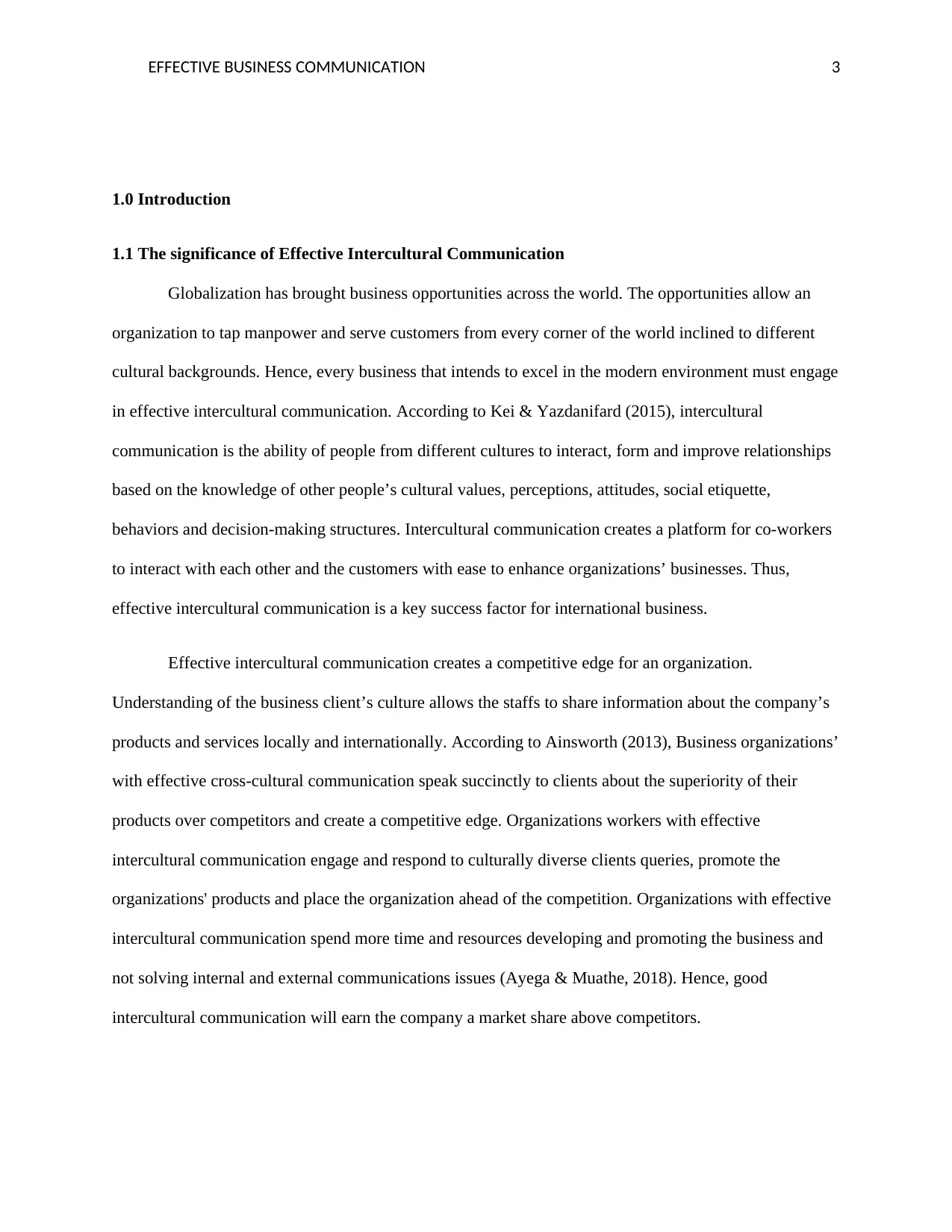
EFFECTIVE BUSINESS COMMUNICATION 3
1.0 Introduction
1.1 The significance of Effective Intercultural Communication
Globalization has brought business opportunities across the world. The opportunities allow an
organization to tap manpower and serve customers from every corner of the world inclined to different
cultural backgrounds. Hence, every business that intends to excel in the modern environment must engage
in effective intercultural communication. According to Kei & Yazdanifard (2015), intercultural
communication is the ability of people from different cultures to interact, form and improve relationships
based on the knowledge of other people’s cultural values, perceptions, attitudes, social etiquette,
behaviors and decision-making structures. Intercultural communication creates a platform for co-workers
to interact with each other and the customers with ease to enhance organizations’ businesses. Thus,
effective intercultural communication is a key success factor for international business.
Effective intercultural communication creates a competitive edge for an organization.
Understanding of the business client’s culture allows the staffs to share information about the company’s
products and services locally and internationally. According to Ainsworth (2013), Business organizations’
with effective cross-cultural communication speak succinctly to clients about the superiority of their
products over competitors and create a competitive edge. Organizations workers with effective
intercultural communication engage and respond to culturally diverse clients queries, promote the
organizations' products and place the organization ahead of the competition. Organizations with effective
intercultural communication spend more time and resources developing and promoting the business and
not solving internal and external communications issues (Ayega & Muathe, 2018). Hence, good
intercultural communication will earn the company a market share above competitors.
1.0 Introduction
1.1 The significance of Effective Intercultural Communication
Globalization has brought business opportunities across the world. The opportunities allow an
organization to tap manpower and serve customers from every corner of the world inclined to different
cultural backgrounds. Hence, every business that intends to excel in the modern environment must engage
in effective intercultural communication. According to Kei & Yazdanifard (2015), intercultural
communication is the ability of people from different cultures to interact, form and improve relationships
based on the knowledge of other people’s cultural values, perceptions, attitudes, social etiquette,
behaviors and decision-making structures. Intercultural communication creates a platform for co-workers
to interact with each other and the customers with ease to enhance organizations’ businesses. Thus,
effective intercultural communication is a key success factor for international business.
Effective intercultural communication creates a competitive edge for an organization.
Understanding of the business client’s culture allows the staffs to share information about the company’s
products and services locally and internationally. According to Ainsworth (2013), Business organizations’
with effective cross-cultural communication speak succinctly to clients about the superiority of their
products over competitors and create a competitive edge. Organizations workers with effective
intercultural communication engage and respond to culturally diverse clients queries, promote the
organizations' products and place the organization ahead of the competition. Organizations with effective
intercultural communication spend more time and resources developing and promoting the business and
not solving internal and external communications issues (Ayega & Muathe, 2018). Hence, good
intercultural communication will earn the company a market share above competitors.
⊘ This is a preview!⊘
Do you want full access?
Subscribe today to unlock all pages.

Trusted by 1+ million students worldwide
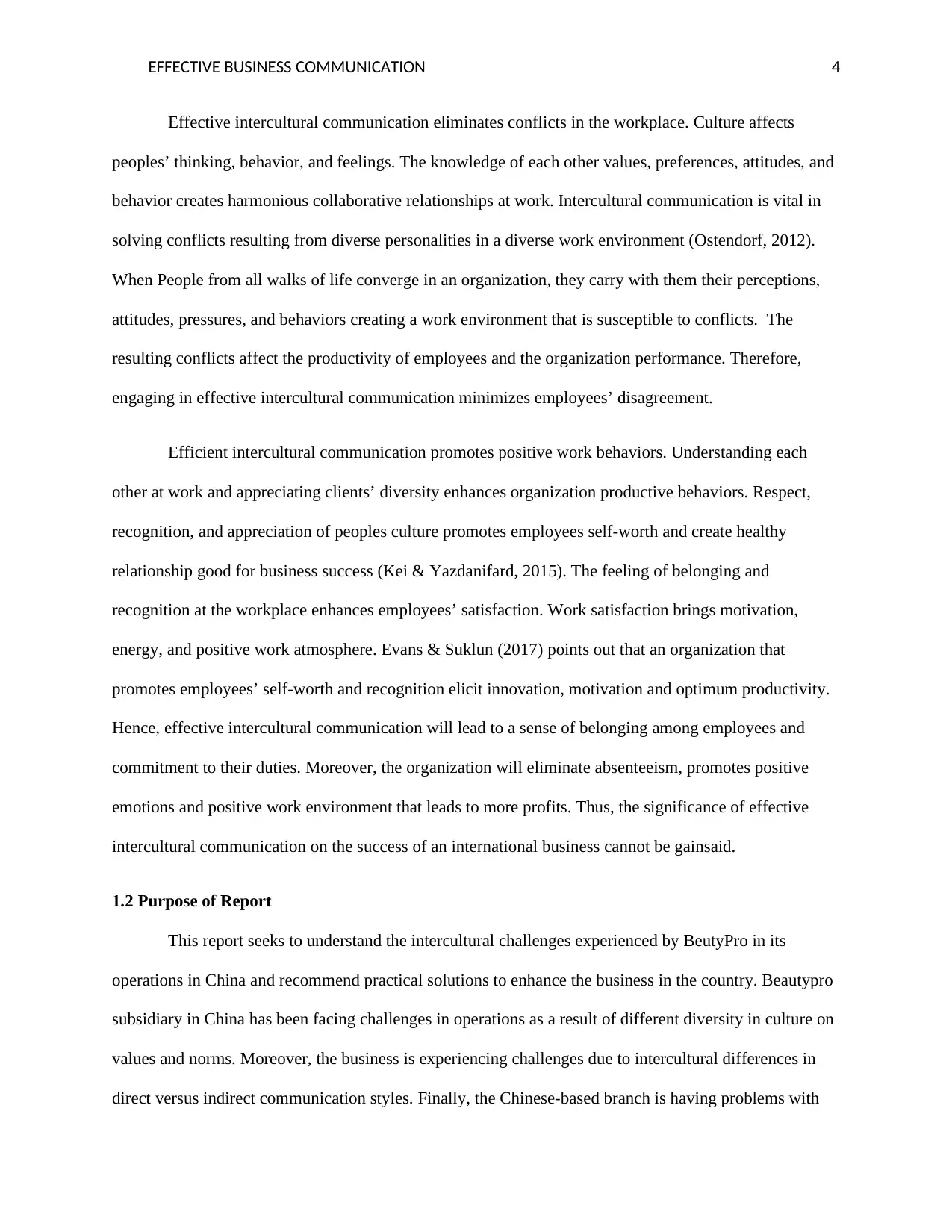
EFFECTIVE BUSINESS COMMUNICATION 4
Effective intercultural communication eliminates conflicts in the workplace. Culture affects
peoples’ thinking, behavior, and feelings. The knowledge of each other values, preferences, attitudes, and
behavior creates harmonious collaborative relationships at work. Intercultural communication is vital in
solving conflicts resulting from diverse personalities in a diverse work environment (Ostendorf, 2012).
When People from all walks of life converge in an organization, they carry with them their perceptions,
attitudes, pressures, and behaviors creating a work environment that is susceptible to conflicts. The
resulting conflicts affect the productivity of employees and the organization performance. Therefore,
engaging in effective intercultural communication minimizes employees’ disagreement.
Efficient intercultural communication promotes positive work behaviors. Understanding each
other at work and appreciating clients’ diversity enhances organization productive behaviors. Respect,
recognition, and appreciation of peoples culture promotes employees self-worth and create healthy
relationship good for business success (Kei & Yazdanifard, 2015). The feeling of belonging and
recognition at the workplace enhances employees’ satisfaction. Work satisfaction brings motivation,
energy, and positive work atmosphere. Evans & Suklun (2017) points out that an organization that
promotes employees’ self-worth and recognition elicit innovation, motivation and optimum productivity.
Hence, effective intercultural communication will lead to a sense of belonging among employees and
commitment to their duties. Moreover, the organization will eliminate absenteeism, promotes positive
emotions and positive work environment that leads to more profits. Thus, the significance of effective
intercultural communication on the success of an international business cannot be gainsaid.
1.2 Purpose of Report
This report seeks to understand the intercultural challenges experienced by BeutyPro in its
operations in China and recommend practical solutions to enhance the business in the country. Beautypro
subsidiary in China has been facing challenges in operations as a result of different diversity in culture on
values and norms. Moreover, the business is experiencing challenges due to intercultural differences in
direct versus indirect communication styles. Finally, the Chinese-based branch is having problems with
Effective intercultural communication eliminates conflicts in the workplace. Culture affects
peoples’ thinking, behavior, and feelings. The knowledge of each other values, preferences, attitudes, and
behavior creates harmonious collaborative relationships at work. Intercultural communication is vital in
solving conflicts resulting from diverse personalities in a diverse work environment (Ostendorf, 2012).
When People from all walks of life converge in an organization, they carry with them their perceptions,
attitudes, pressures, and behaviors creating a work environment that is susceptible to conflicts. The
resulting conflicts affect the productivity of employees and the organization performance. Therefore,
engaging in effective intercultural communication minimizes employees’ disagreement.
Efficient intercultural communication promotes positive work behaviors. Understanding each
other at work and appreciating clients’ diversity enhances organization productive behaviors. Respect,
recognition, and appreciation of peoples culture promotes employees self-worth and create healthy
relationship good for business success (Kei & Yazdanifard, 2015). The feeling of belonging and
recognition at the workplace enhances employees’ satisfaction. Work satisfaction brings motivation,
energy, and positive work atmosphere. Evans & Suklun (2017) points out that an organization that
promotes employees’ self-worth and recognition elicit innovation, motivation and optimum productivity.
Hence, effective intercultural communication will lead to a sense of belonging among employees and
commitment to their duties. Moreover, the organization will eliminate absenteeism, promotes positive
emotions and positive work environment that leads to more profits. Thus, the significance of effective
intercultural communication on the success of an international business cannot be gainsaid.
1.2 Purpose of Report
This report seeks to understand the intercultural challenges experienced by BeutyPro in its
operations in China and recommend practical solutions to enhance the business in the country. Beautypro
subsidiary in China has been facing challenges in operations as a result of different diversity in culture on
values and norms. Moreover, the business is experiencing challenges due to intercultural differences in
direct versus indirect communication styles. Finally, the Chinese-based branch is having problems with
Paraphrase This Document
Need a fresh take? Get an instant paraphrase of this document with our AI Paraphraser
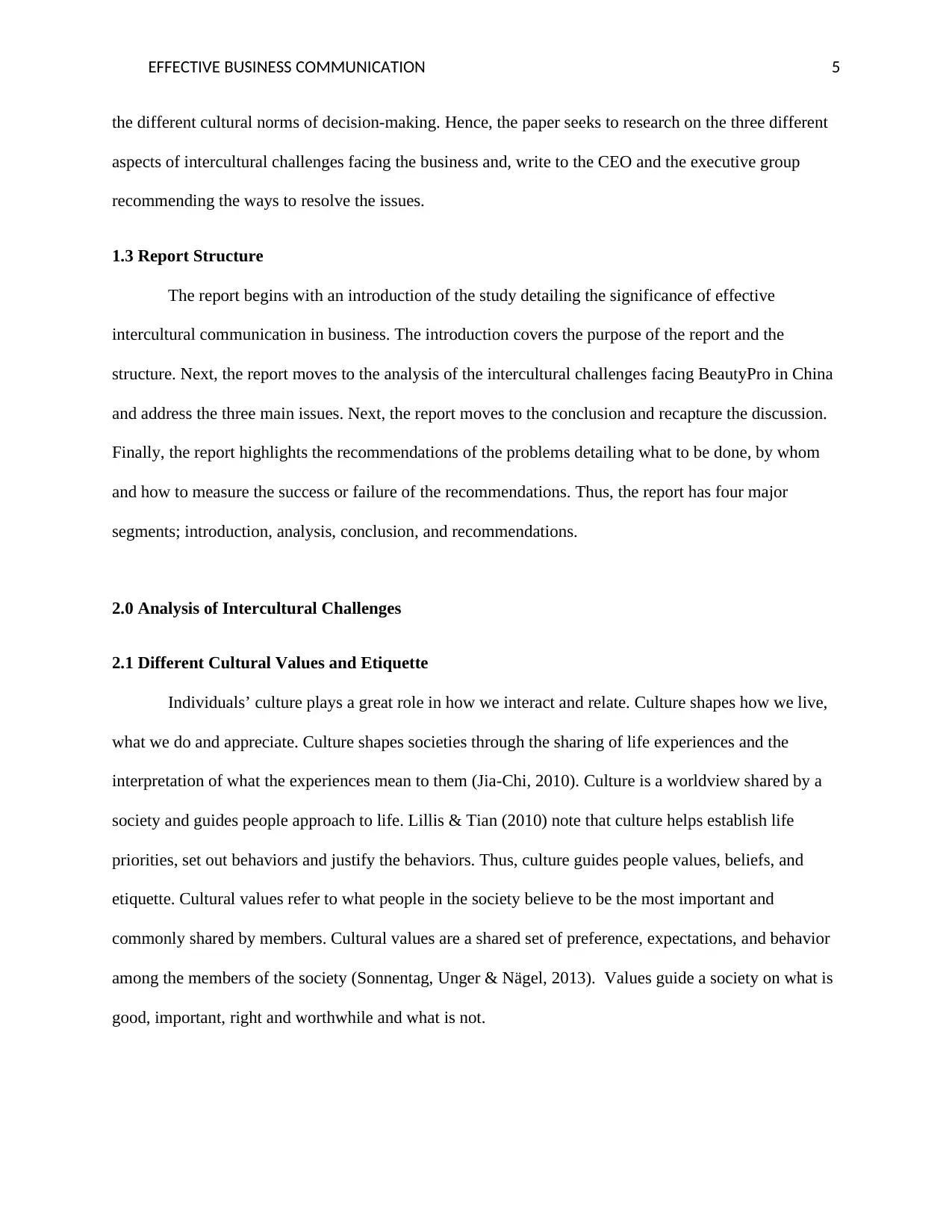
EFFECTIVE BUSINESS COMMUNICATION 5
the different cultural norms of decision-making. Hence, the paper seeks to research on the three different
aspects of intercultural challenges facing the business and, write to the CEO and the executive group
recommending the ways to resolve the issues.
1.3 Report Structure
The report begins with an introduction of the study detailing the significance of effective
intercultural communication in business. The introduction covers the purpose of the report and the
structure. Next, the report moves to the analysis of the intercultural challenges facing BeautyPro in China
and address the three main issues. Next, the report moves to the conclusion and recapture the discussion.
Finally, the report highlights the recommendations of the problems detailing what to be done, by whom
and how to measure the success or failure of the recommendations. Thus, the report has four major
segments; introduction, analysis, conclusion, and recommendations.
2.0 Analysis of Intercultural Challenges
2.1 Different Cultural Values and Etiquette
Individuals’ culture plays a great role in how we interact and relate. Culture shapes how we live,
what we do and appreciate. Culture shapes societies through the sharing of life experiences and the
interpretation of what the experiences mean to them (Jia-Chi, 2010). Culture is a worldview shared by a
society and guides people approach to life. Lillis & Tian (2010) note that culture helps establish life
priorities, set out behaviors and justify the behaviors. Thus, culture guides people values, beliefs, and
etiquette. Cultural values refer to what people in the society believe to be the most important and
commonly shared by members. Cultural values are a shared set of preference, expectations, and behavior
among the members of the society (Sonnentag, Unger & Nägel, 2013). Values guide a society on what is
good, important, right and worthwhile and what is not.
the different cultural norms of decision-making. Hence, the paper seeks to research on the three different
aspects of intercultural challenges facing the business and, write to the CEO and the executive group
recommending the ways to resolve the issues.
1.3 Report Structure
The report begins with an introduction of the study detailing the significance of effective
intercultural communication in business. The introduction covers the purpose of the report and the
structure. Next, the report moves to the analysis of the intercultural challenges facing BeautyPro in China
and address the three main issues. Next, the report moves to the conclusion and recapture the discussion.
Finally, the report highlights the recommendations of the problems detailing what to be done, by whom
and how to measure the success or failure of the recommendations. Thus, the report has four major
segments; introduction, analysis, conclusion, and recommendations.
2.0 Analysis of Intercultural Challenges
2.1 Different Cultural Values and Etiquette
Individuals’ culture plays a great role in how we interact and relate. Culture shapes how we live,
what we do and appreciate. Culture shapes societies through the sharing of life experiences and the
interpretation of what the experiences mean to them (Jia-Chi, 2010). Culture is a worldview shared by a
society and guides people approach to life. Lillis & Tian (2010) note that culture helps establish life
priorities, set out behaviors and justify the behaviors. Thus, culture guides people values, beliefs, and
etiquette. Cultural values refer to what people in the society believe to be the most important and
commonly shared by members. Cultural values are a shared set of preference, expectations, and behavior
among the members of the society (Sonnentag, Unger & Nägel, 2013). Values guide a society on what is
good, important, right and worthwhile and what is not.
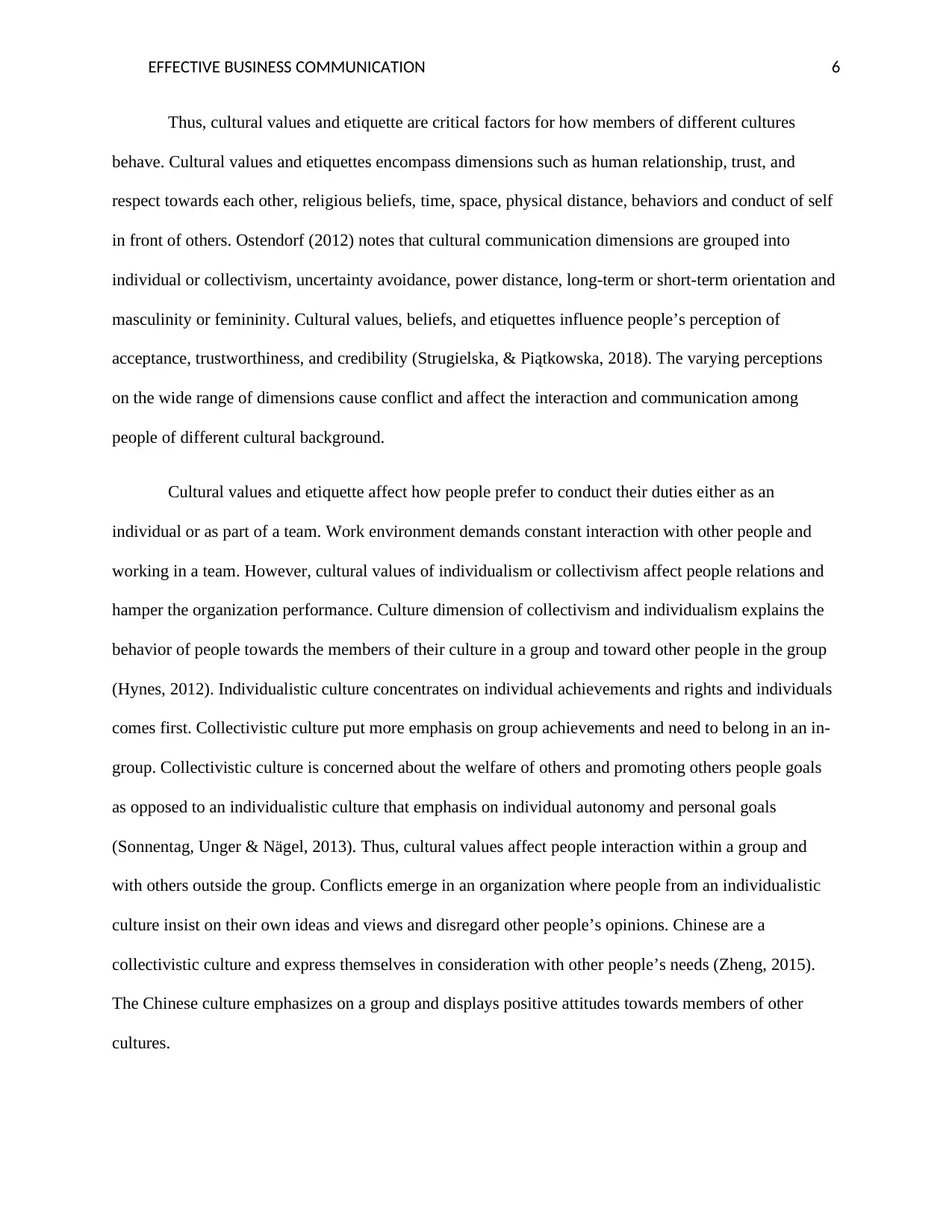
EFFECTIVE BUSINESS COMMUNICATION 6
Thus, cultural values and etiquette are critical factors for how members of different cultures
behave. Cultural values and etiquettes encompass dimensions such as human relationship, trust, and
respect towards each other, religious beliefs, time, space, physical distance, behaviors and conduct of self
in front of others. Ostendorf (2012) notes that cultural communication dimensions are grouped into
individual or collectivism, uncertainty avoidance, power distance, long-term or short-term orientation and
masculinity or femininity. Cultural values, beliefs, and etiquettes influence people’s perception of
acceptance, trustworthiness, and credibility (Strugielska, & Piątkowska, 2018). The varying perceptions
on the wide range of dimensions cause conflict and affect the interaction and communication among
people of different cultural background.
Cultural values and etiquette affect how people prefer to conduct their duties either as an
individual or as part of a team. Work environment demands constant interaction with other people and
working in a team. However, cultural values of individualism or collectivism affect people relations and
hamper the organization performance. Culture dimension of collectivism and individualism explains the
behavior of people towards the members of their culture in a group and toward other people in the group
(Hynes, 2012). Individualistic culture concentrates on individual achievements and rights and individuals
comes first. Collectivistic culture put more emphasis on group achievements and need to belong in an in-
group. Collectivistic culture is concerned about the welfare of others and promoting others people goals
as opposed to an individualistic culture that emphasis on individual autonomy and personal goals
(Sonnentag, Unger & Nägel, 2013). Thus, cultural values affect people interaction within a group and
with others outside the group. Conflicts emerge in an organization where people from an individualistic
culture insist on their own ideas and views and disregard other people’s opinions. Chinese are a
collectivistic culture and express themselves in consideration with other people’s needs (Zheng, 2015).
The Chinese culture emphasizes on a group and displays positive attitudes towards members of other
cultures.
Thus, cultural values and etiquette are critical factors for how members of different cultures
behave. Cultural values and etiquettes encompass dimensions such as human relationship, trust, and
respect towards each other, religious beliefs, time, space, physical distance, behaviors and conduct of self
in front of others. Ostendorf (2012) notes that cultural communication dimensions are grouped into
individual or collectivism, uncertainty avoidance, power distance, long-term or short-term orientation and
masculinity or femininity. Cultural values, beliefs, and etiquettes influence people’s perception of
acceptance, trustworthiness, and credibility (Strugielska, & Piątkowska, 2018). The varying perceptions
on the wide range of dimensions cause conflict and affect the interaction and communication among
people of different cultural background.
Cultural values and etiquette affect how people prefer to conduct their duties either as an
individual or as part of a team. Work environment demands constant interaction with other people and
working in a team. However, cultural values of individualism or collectivism affect people relations and
hamper the organization performance. Culture dimension of collectivism and individualism explains the
behavior of people towards the members of their culture in a group and toward other people in the group
(Hynes, 2012). Individualistic culture concentrates on individual achievements and rights and individuals
comes first. Collectivistic culture put more emphasis on group achievements and need to belong in an in-
group. Collectivistic culture is concerned about the welfare of others and promoting others people goals
as opposed to an individualistic culture that emphasis on individual autonomy and personal goals
(Sonnentag, Unger & Nägel, 2013). Thus, cultural values affect people interaction within a group and
with others outside the group. Conflicts emerge in an organization where people from an individualistic
culture insist on their own ideas and views and disregard other people’s opinions. Chinese are a
collectivistic culture and express themselves in consideration with other people’s needs (Zheng, 2015).
The Chinese culture emphasizes on a group and displays positive attitudes towards members of other
cultures.
⊘ This is a preview!⊘
Do you want full access?
Subscribe today to unlock all pages.

Trusted by 1+ million students worldwide
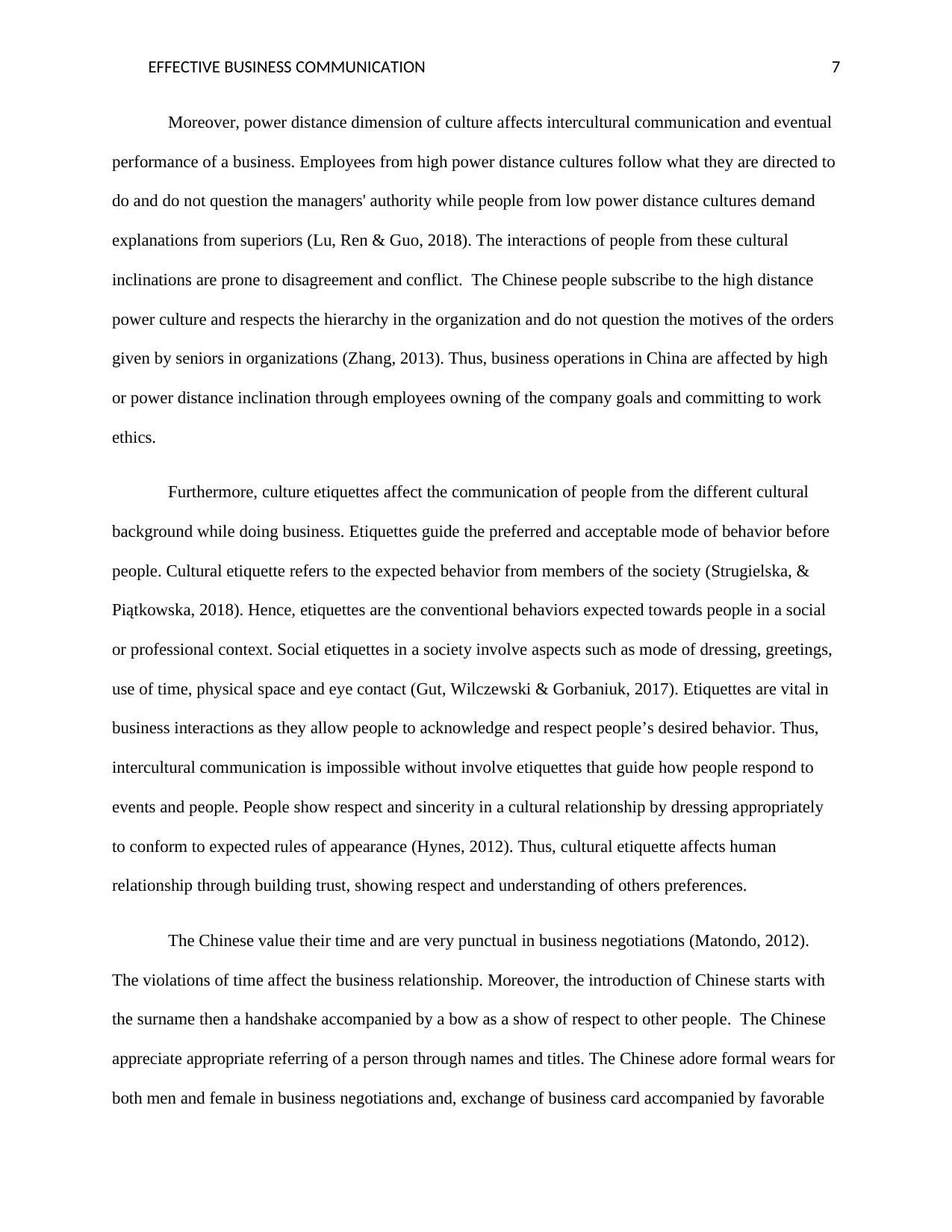
EFFECTIVE BUSINESS COMMUNICATION 7
Moreover, power distance dimension of culture affects intercultural communication and eventual
performance of a business. Employees from high power distance cultures follow what they are directed to
do and do not question the managers' authority while people from low power distance cultures demand
explanations from superiors (Lu, Ren & Guo, 2018). The interactions of people from these cultural
inclinations are prone to disagreement and conflict. The Chinese people subscribe to the high distance
power culture and respects the hierarchy in the organization and do not question the motives of the orders
given by seniors in organizations (Zhang, 2013). Thus, business operations in China are affected by high
or power distance inclination through employees owning of the company goals and committing to work
ethics.
Furthermore, culture etiquettes affect the communication of people from the different cultural
background while doing business. Etiquettes guide the preferred and acceptable mode of behavior before
people. Cultural etiquette refers to the expected behavior from members of the society (Strugielska, &
Piątkowska, 2018). Hence, etiquettes are the conventional behaviors expected towards people in a social
or professional context. Social etiquettes in a society involve aspects such as mode of dressing, greetings,
use of time, physical space and eye contact (Gut, Wilczewski & Gorbaniuk, 2017). Etiquettes are vital in
business interactions as they allow people to acknowledge and respect people’s desired behavior. Thus,
intercultural communication is impossible without involve etiquettes that guide how people respond to
events and people. People show respect and sincerity in a cultural relationship by dressing appropriately
to conform to expected rules of appearance (Hynes, 2012). Thus, cultural etiquette affects human
relationship through building trust, showing respect and understanding of others preferences.
The Chinese value their time and are very punctual in business negotiations (Matondo, 2012).
The violations of time affect the business relationship. Moreover, the introduction of Chinese starts with
the surname then a handshake accompanied by a bow as a show of respect to other people. The Chinese
appreciate appropriate referring of a person through names and titles. The Chinese adore formal wears for
both men and female in business negotiations and, exchange of business card accompanied by favorable
Moreover, power distance dimension of culture affects intercultural communication and eventual
performance of a business. Employees from high power distance cultures follow what they are directed to
do and do not question the managers' authority while people from low power distance cultures demand
explanations from superiors (Lu, Ren & Guo, 2018). The interactions of people from these cultural
inclinations are prone to disagreement and conflict. The Chinese people subscribe to the high distance
power culture and respects the hierarchy in the organization and do not question the motives of the orders
given by seniors in organizations (Zhang, 2013). Thus, business operations in China are affected by high
or power distance inclination through employees owning of the company goals and committing to work
ethics.
Furthermore, culture etiquettes affect the communication of people from the different cultural
background while doing business. Etiquettes guide the preferred and acceptable mode of behavior before
people. Cultural etiquette refers to the expected behavior from members of the society (Strugielska, &
Piątkowska, 2018). Hence, etiquettes are the conventional behaviors expected towards people in a social
or professional context. Social etiquettes in a society involve aspects such as mode of dressing, greetings,
use of time, physical space and eye contact (Gut, Wilczewski & Gorbaniuk, 2017). Etiquettes are vital in
business interactions as they allow people to acknowledge and respect people’s desired behavior. Thus,
intercultural communication is impossible without involve etiquettes that guide how people respond to
events and people. People show respect and sincerity in a cultural relationship by dressing appropriately
to conform to expected rules of appearance (Hynes, 2012). Thus, cultural etiquette affects human
relationship through building trust, showing respect and understanding of others preferences.
The Chinese value their time and are very punctual in business negotiations (Matondo, 2012).
The violations of time affect the business relationship. Moreover, the introduction of Chinese starts with
the surname then a handshake accompanied by a bow as a show of respect to other people. The Chinese
appreciate appropriate referring of a person through names and titles. The Chinese adore formal wears for
both men and female in business negotiations and, exchange of business card accompanied by favorable
Paraphrase This Document
Need a fresh take? Get an instant paraphrase of this document with our AI Paraphraser
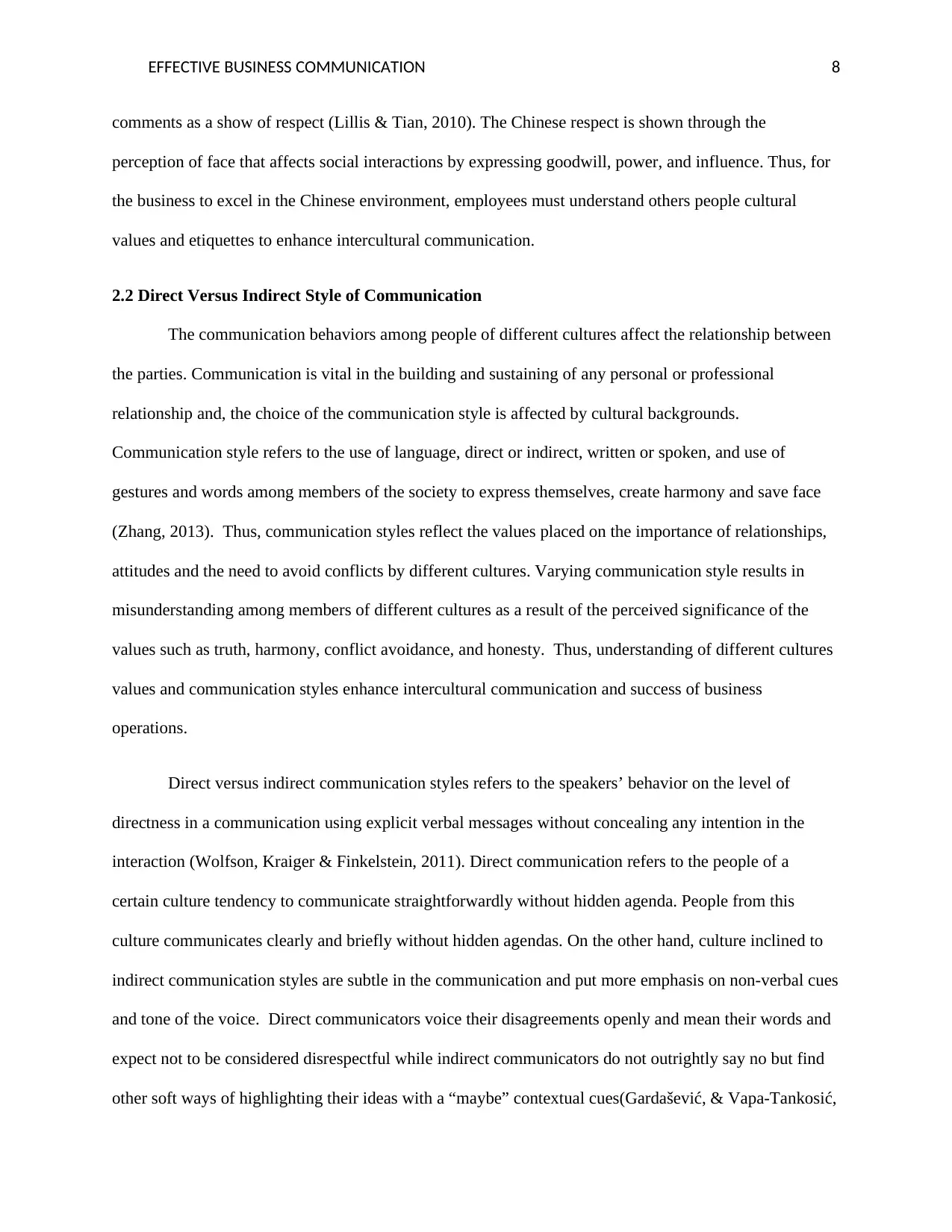
EFFECTIVE BUSINESS COMMUNICATION 8
comments as a show of respect (Lillis & Tian, 2010). The Chinese respect is shown through the
perception of face that affects social interactions by expressing goodwill, power, and influence. Thus, for
the business to excel in the Chinese environment, employees must understand others people cultural
values and etiquettes to enhance intercultural communication.
2.2 Direct Versus Indirect Style of Communication
The communication behaviors among people of different cultures affect the relationship between
the parties. Communication is vital in the building and sustaining of any personal or professional
relationship and, the choice of the communication style is affected by cultural backgrounds.
Communication style refers to the use of language, direct or indirect, written or spoken, and use of
gestures and words among members of the society to express themselves, create harmony and save face
(Zhang, 2013). Thus, communication styles reflect the values placed on the importance of relationships,
attitudes and the need to avoid conflicts by different cultures. Varying communication style results in
misunderstanding among members of different cultures as a result of the perceived significance of the
values such as truth, harmony, conflict avoidance, and honesty. Thus, understanding of different cultures
values and communication styles enhance intercultural communication and success of business
operations.
Direct versus indirect communication styles refers to the speakers’ behavior on the level of
directness in a communication using explicit verbal messages without concealing any intention in the
interaction (Wolfson, Kraiger & Finkelstein, 2011). Direct communication refers to the people of a
certain culture tendency to communicate straightforwardly without hidden agenda. People from this
culture communicates clearly and briefly without hidden agendas. On the other hand, culture inclined to
indirect communication styles are subtle in the communication and put more emphasis on non-verbal cues
and tone of the voice. Direct communicators voice their disagreements openly and mean their words and
expect not to be considered disrespectful while indirect communicators do not outrightly say no but find
other soft ways of highlighting their ideas with a “maybe” contextual cues(Gardašević, & Vapa-Tankosić,
comments as a show of respect (Lillis & Tian, 2010). The Chinese respect is shown through the
perception of face that affects social interactions by expressing goodwill, power, and influence. Thus, for
the business to excel in the Chinese environment, employees must understand others people cultural
values and etiquettes to enhance intercultural communication.
2.2 Direct Versus Indirect Style of Communication
The communication behaviors among people of different cultures affect the relationship between
the parties. Communication is vital in the building and sustaining of any personal or professional
relationship and, the choice of the communication style is affected by cultural backgrounds.
Communication style refers to the use of language, direct or indirect, written or spoken, and use of
gestures and words among members of the society to express themselves, create harmony and save face
(Zhang, 2013). Thus, communication styles reflect the values placed on the importance of relationships,
attitudes and the need to avoid conflicts by different cultures. Varying communication style results in
misunderstanding among members of different cultures as a result of the perceived significance of the
values such as truth, harmony, conflict avoidance, and honesty. Thus, understanding of different cultures
values and communication styles enhance intercultural communication and success of business
operations.
Direct versus indirect communication styles refers to the speakers’ behavior on the level of
directness in a communication using explicit verbal messages without concealing any intention in the
interaction (Wolfson, Kraiger & Finkelstein, 2011). Direct communication refers to the people of a
certain culture tendency to communicate straightforwardly without hidden agenda. People from this
culture communicates clearly and briefly without hidden agendas. On the other hand, culture inclined to
indirect communication styles are subtle in the communication and put more emphasis on non-verbal cues
and tone of the voice. Direct communicators voice their disagreements openly and mean their words and
expect not to be considered disrespectful while indirect communicators do not outrightly say no but find
other soft ways of highlighting their ideas with a “maybe” contextual cues(Gardašević, & Vapa-Tankosić,
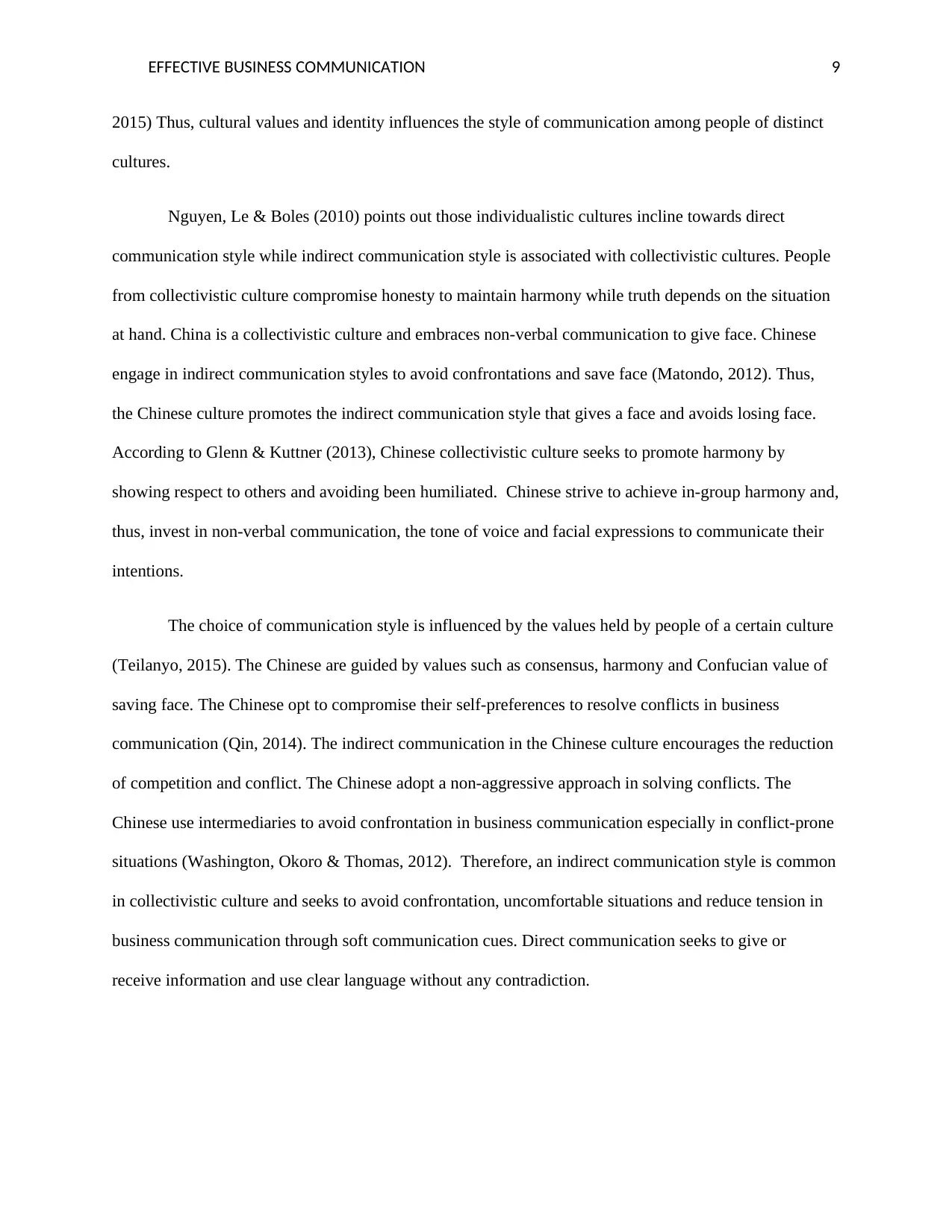
EFFECTIVE BUSINESS COMMUNICATION 9
2015) Thus, cultural values and identity influences the style of communication among people of distinct
cultures.
Nguyen, Le & Boles (2010) points out those individualistic cultures incline towards direct
communication style while indirect communication style is associated with collectivistic cultures. People
from collectivistic culture compromise honesty to maintain harmony while truth depends on the situation
at hand. China is a collectivistic culture and embraces non-verbal communication to give face. Chinese
engage in indirect communication styles to avoid confrontations and save face (Matondo, 2012). Thus,
the Chinese culture promotes the indirect communication style that gives a face and avoids losing face.
According to Glenn & Kuttner (2013), Chinese collectivistic culture seeks to promote harmony by
showing respect to others and avoiding been humiliated. Chinese strive to achieve in-group harmony and,
thus, invest in non-verbal communication, the tone of voice and facial expressions to communicate their
intentions.
The choice of communication style is influenced by the values held by people of a certain culture
(Teilanyo, 2015). The Chinese are guided by values such as consensus, harmony and Confucian value of
saving face. The Chinese opt to compromise their self-preferences to resolve conflicts in business
communication (Qin, 2014). The indirect communication in the Chinese culture encourages the reduction
of competition and conflict. The Chinese adopt a non-aggressive approach in solving conflicts. The
Chinese use intermediaries to avoid confrontation in business communication especially in conflict-prone
situations (Washington, Okoro & Thomas, 2012). Therefore, an indirect communication style is common
in collectivistic culture and seeks to avoid confrontation, uncomfortable situations and reduce tension in
business communication through soft communication cues. Direct communication seeks to give or
receive information and use clear language without any contradiction.
2015) Thus, cultural values and identity influences the style of communication among people of distinct
cultures.
Nguyen, Le & Boles (2010) points out those individualistic cultures incline towards direct
communication style while indirect communication style is associated with collectivistic cultures. People
from collectivistic culture compromise honesty to maintain harmony while truth depends on the situation
at hand. China is a collectivistic culture and embraces non-verbal communication to give face. Chinese
engage in indirect communication styles to avoid confrontations and save face (Matondo, 2012). Thus,
the Chinese culture promotes the indirect communication style that gives a face and avoids losing face.
According to Glenn & Kuttner (2013), Chinese collectivistic culture seeks to promote harmony by
showing respect to others and avoiding been humiliated. Chinese strive to achieve in-group harmony and,
thus, invest in non-verbal communication, the tone of voice and facial expressions to communicate their
intentions.
The choice of communication style is influenced by the values held by people of a certain culture
(Teilanyo, 2015). The Chinese are guided by values such as consensus, harmony and Confucian value of
saving face. The Chinese opt to compromise their self-preferences to resolve conflicts in business
communication (Qin, 2014). The indirect communication in the Chinese culture encourages the reduction
of competition and conflict. The Chinese adopt a non-aggressive approach in solving conflicts. The
Chinese use intermediaries to avoid confrontation in business communication especially in conflict-prone
situations (Washington, Okoro & Thomas, 2012). Therefore, an indirect communication style is common
in collectivistic culture and seeks to avoid confrontation, uncomfortable situations and reduce tension in
business communication through soft communication cues. Direct communication seeks to give or
receive information and use clear language without any contradiction.
⊘ This is a preview!⊘
Do you want full access?
Subscribe today to unlock all pages.

Trusted by 1+ million students worldwide
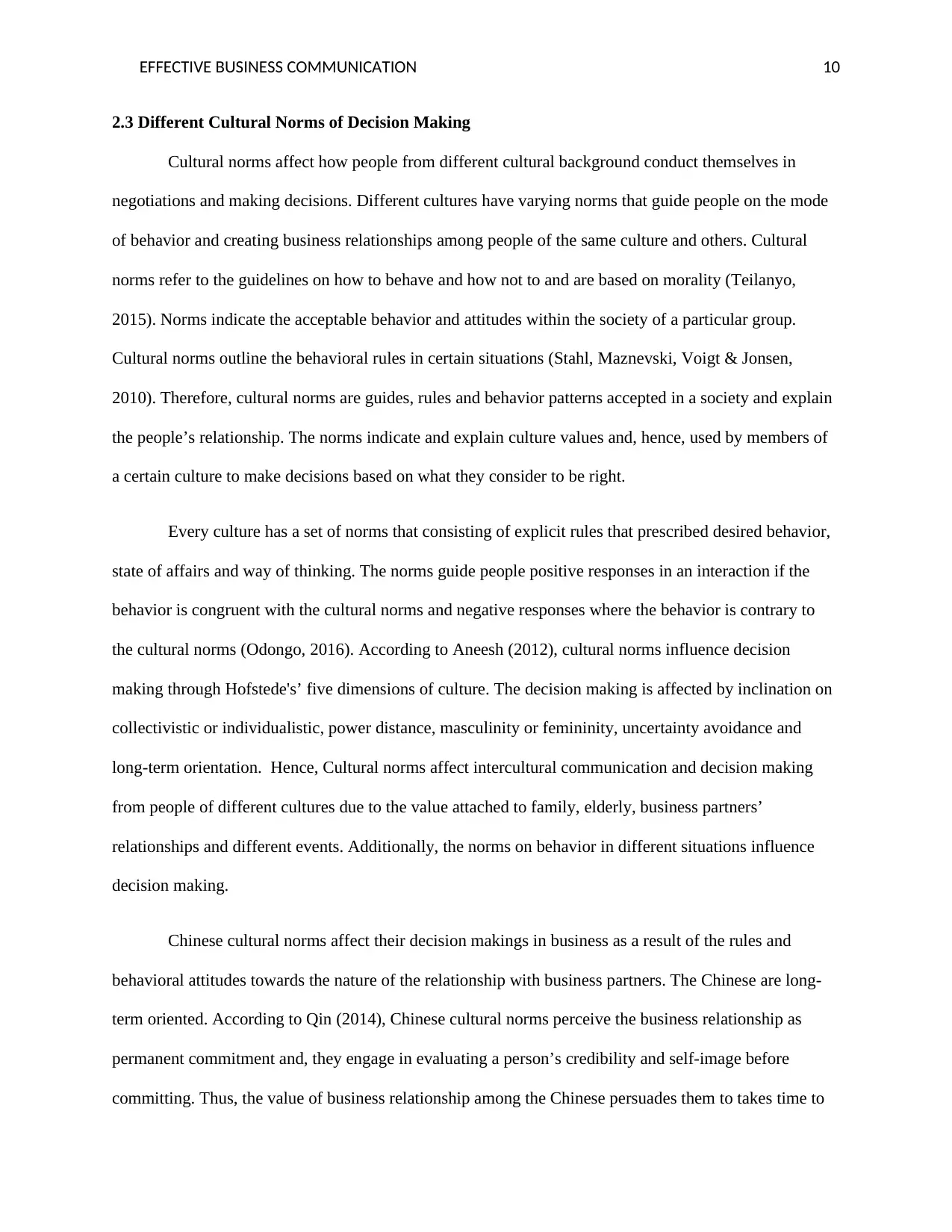
EFFECTIVE BUSINESS COMMUNICATION 10
2.3 Different Cultural Norms of Decision Making
Cultural norms affect how people from different cultural background conduct themselves in
negotiations and making decisions. Different cultures have varying norms that guide people on the mode
of behavior and creating business relationships among people of the same culture and others. Cultural
norms refer to the guidelines on how to behave and how not to and are based on morality (Teilanyo,
2015). Norms indicate the acceptable behavior and attitudes within the society of a particular group.
Cultural norms outline the behavioral rules in certain situations (Stahl, Maznevski, Voigt & Jonsen,
2010). Therefore, cultural norms are guides, rules and behavior patterns accepted in a society and explain
the people’s relationship. The norms indicate and explain culture values and, hence, used by members of
a certain culture to make decisions based on what they consider to be right.
Every culture has a set of norms that consisting of explicit rules that prescribed desired behavior,
state of affairs and way of thinking. The norms guide people positive responses in an interaction if the
behavior is congruent with the cultural norms and negative responses where the behavior is contrary to
the cultural norms (Odongo, 2016). According to Aneesh (2012), cultural norms influence decision
making through Hofstede's’ five dimensions of culture. The decision making is affected by inclination on
collectivistic or individualistic, power distance, masculinity or femininity, uncertainty avoidance and
long-term orientation. Hence, Cultural norms affect intercultural communication and decision making
from people of different cultures due to the value attached to family, elderly, business partners’
relationships and different events. Additionally, the norms on behavior in different situations influence
decision making.
Chinese cultural norms affect their decision makings in business as a result of the rules and
behavioral attitudes towards the nature of the relationship with business partners. The Chinese are long-
term oriented. According to Qin (2014), Chinese cultural norms perceive the business relationship as
permanent commitment and, they engage in evaluating a person’s credibility and self-image before
committing. Thus, the value of business relationship among the Chinese persuades them to takes time to
2.3 Different Cultural Norms of Decision Making
Cultural norms affect how people from different cultural background conduct themselves in
negotiations and making decisions. Different cultures have varying norms that guide people on the mode
of behavior and creating business relationships among people of the same culture and others. Cultural
norms refer to the guidelines on how to behave and how not to and are based on morality (Teilanyo,
2015). Norms indicate the acceptable behavior and attitudes within the society of a particular group.
Cultural norms outline the behavioral rules in certain situations (Stahl, Maznevski, Voigt & Jonsen,
2010). Therefore, cultural norms are guides, rules and behavior patterns accepted in a society and explain
the people’s relationship. The norms indicate and explain culture values and, hence, used by members of
a certain culture to make decisions based on what they consider to be right.
Every culture has a set of norms that consisting of explicit rules that prescribed desired behavior,
state of affairs and way of thinking. The norms guide people positive responses in an interaction if the
behavior is congruent with the cultural norms and negative responses where the behavior is contrary to
the cultural norms (Odongo, 2016). According to Aneesh (2012), cultural norms influence decision
making through Hofstede's’ five dimensions of culture. The decision making is affected by inclination on
collectivistic or individualistic, power distance, masculinity or femininity, uncertainty avoidance and
long-term orientation. Hence, Cultural norms affect intercultural communication and decision making
from people of different cultures due to the value attached to family, elderly, business partners’
relationships and different events. Additionally, the norms on behavior in different situations influence
decision making.
Chinese cultural norms affect their decision makings in business as a result of the rules and
behavioral attitudes towards the nature of the relationship with business partners. The Chinese are long-
term oriented. According to Qin (2014), Chinese cultural norms perceive the business relationship as
permanent commitment and, they engage in evaluating a person’s credibility and self-image before
committing. Thus, the value of business relationship among the Chinese persuades them to takes time to
Paraphrase This Document
Need a fresh take? Get an instant paraphrase of this document with our AI Paraphraser
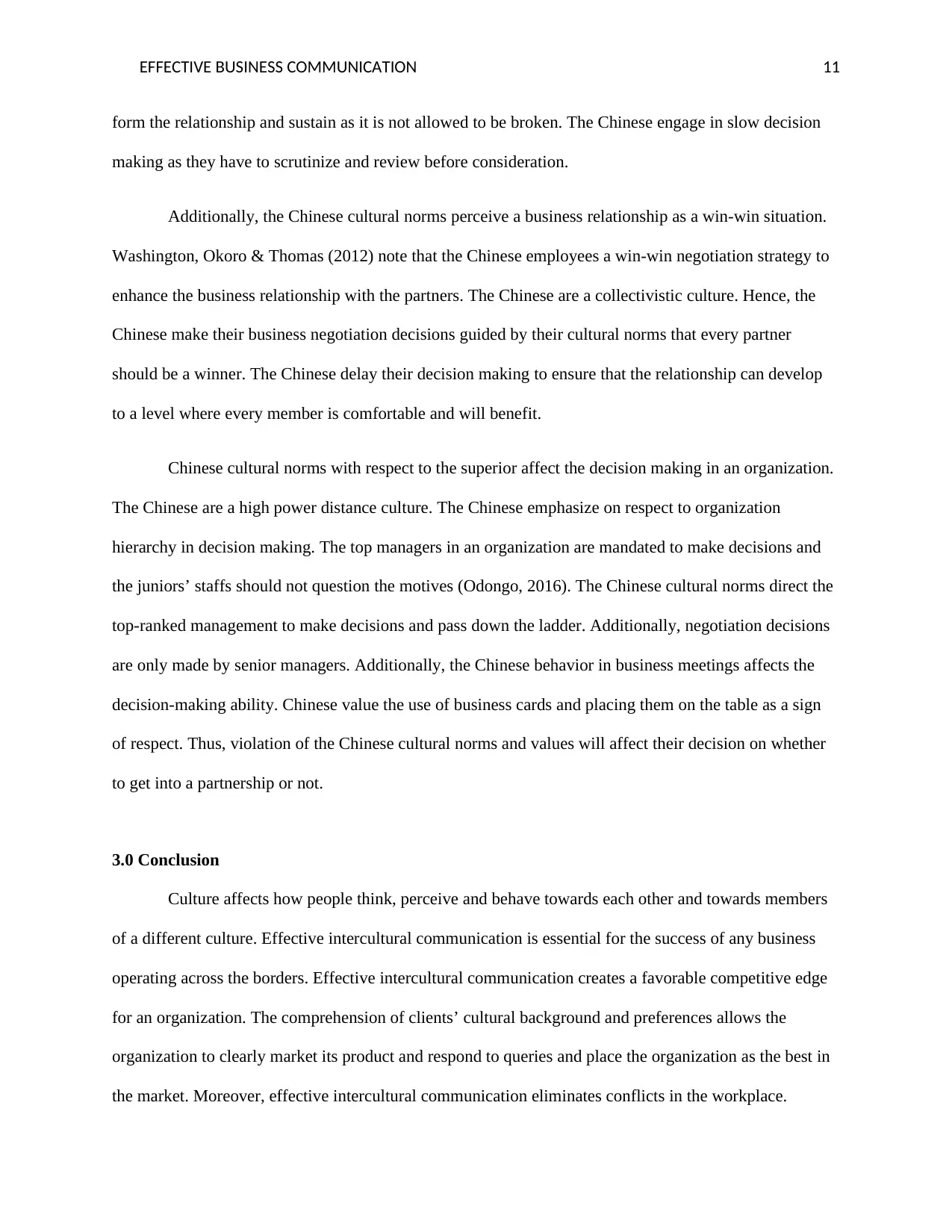
EFFECTIVE BUSINESS COMMUNICATION 11
form the relationship and sustain as it is not allowed to be broken. The Chinese engage in slow decision
making as they have to scrutinize and review before consideration.
Additionally, the Chinese cultural norms perceive a business relationship as a win-win situation.
Washington, Okoro & Thomas (2012) note that the Chinese employees a win-win negotiation strategy to
enhance the business relationship with the partners. The Chinese are a collectivistic culture. Hence, the
Chinese make their business negotiation decisions guided by their cultural norms that every partner
should be a winner. The Chinese delay their decision making to ensure that the relationship can develop
to a level where every member is comfortable and will benefit.
Chinese cultural norms with respect to the superior affect the decision making in an organization.
The Chinese are a high power distance culture. The Chinese emphasize on respect to organization
hierarchy in decision making. The top managers in an organization are mandated to make decisions and
the juniors’ staffs should not question the motives (Odongo, 2016). The Chinese cultural norms direct the
top-ranked management to make decisions and pass down the ladder. Additionally, negotiation decisions
are only made by senior managers. Additionally, the Chinese behavior in business meetings affects the
decision-making ability. Chinese value the use of business cards and placing them on the table as a sign
of respect. Thus, violation of the Chinese cultural norms and values will affect their decision on whether
to get into a partnership or not.
3.0 Conclusion
Culture affects how people think, perceive and behave towards each other and towards members
of a different culture. Effective intercultural communication is essential for the success of any business
operating across the borders. Effective intercultural communication creates a favorable competitive edge
for an organization. The comprehension of clients’ cultural background and preferences allows the
organization to clearly market its product and respond to queries and place the organization as the best in
the market. Moreover, effective intercultural communication eliminates conflicts in the workplace.
form the relationship and sustain as it is not allowed to be broken. The Chinese engage in slow decision
making as they have to scrutinize and review before consideration.
Additionally, the Chinese cultural norms perceive a business relationship as a win-win situation.
Washington, Okoro & Thomas (2012) note that the Chinese employees a win-win negotiation strategy to
enhance the business relationship with the partners. The Chinese are a collectivistic culture. Hence, the
Chinese make their business negotiation decisions guided by their cultural norms that every partner
should be a winner. The Chinese delay their decision making to ensure that the relationship can develop
to a level where every member is comfortable and will benefit.
Chinese cultural norms with respect to the superior affect the decision making in an organization.
The Chinese are a high power distance culture. The Chinese emphasize on respect to organization
hierarchy in decision making. The top managers in an organization are mandated to make decisions and
the juniors’ staffs should not question the motives (Odongo, 2016). The Chinese cultural norms direct the
top-ranked management to make decisions and pass down the ladder. Additionally, negotiation decisions
are only made by senior managers. Additionally, the Chinese behavior in business meetings affects the
decision-making ability. Chinese value the use of business cards and placing them on the table as a sign
of respect. Thus, violation of the Chinese cultural norms and values will affect their decision on whether
to get into a partnership or not.
3.0 Conclusion
Culture affects how people think, perceive and behave towards each other and towards members
of a different culture. Effective intercultural communication is essential for the success of any business
operating across the borders. Effective intercultural communication creates a favorable competitive edge
for an organization. The comprehension of clients’ cultural background and preferences allows the
organization to clearly market its product and respond to queries and place the organization as the best in
the market. Moreover, effective intercultural communication eliminates conflicts in the workplace.
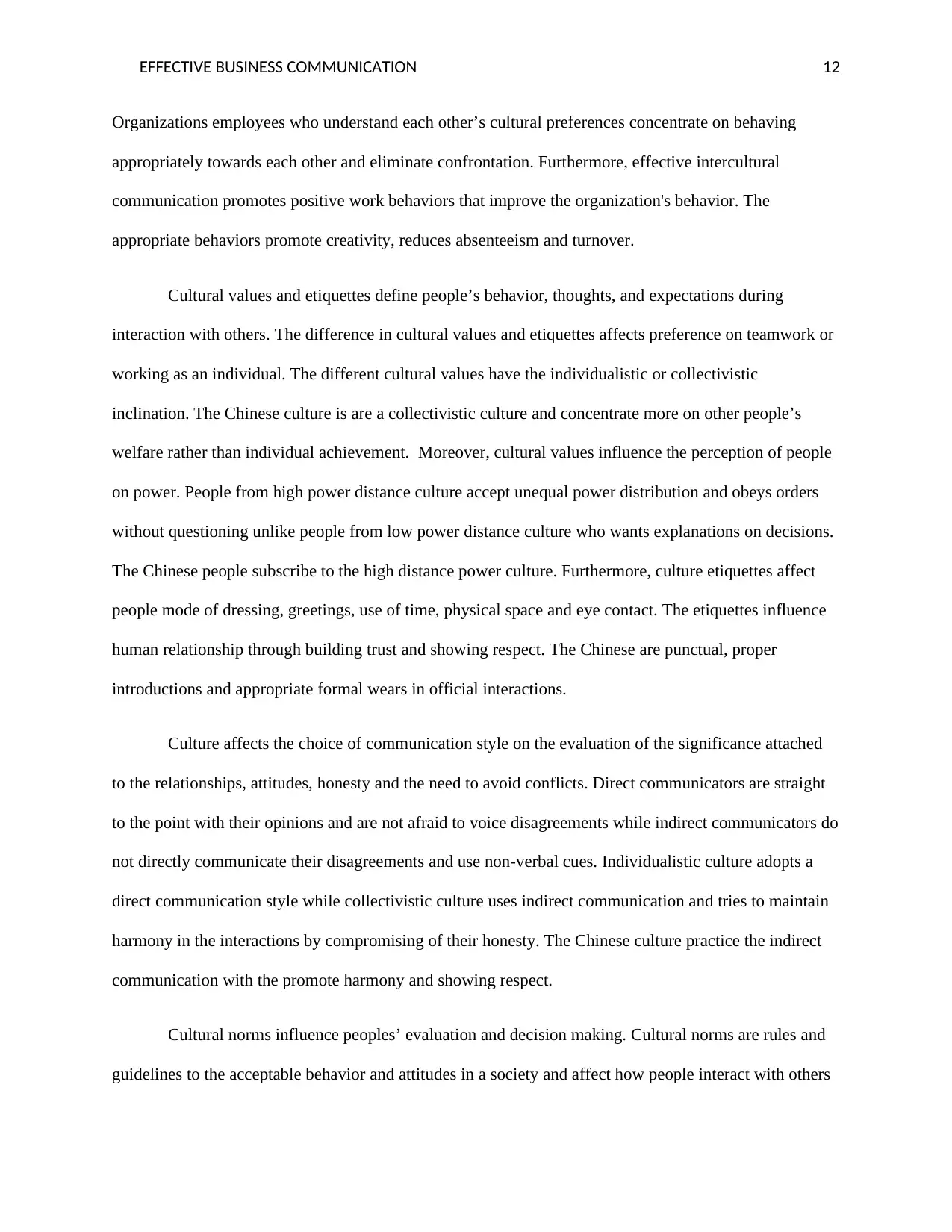
EFFECTIVE BUSINESS COMMUNICATION 12
Organizations employees who understand each other’s cultural preferences concentrate on behaving
appropriately towards each other and eliminate confrontation. Furthermore, effective intercultural
communication promotes positive work behaviors that improve the organization's behavior. The
appropriate behaviors promote creativity, reduces absenteeism and turnover.
Cultural values and etiquettes define people’s behavior, thoughts, and expectations during
interaction with others. The difference in cultural values and etiquettes affects preference on teamwork or
working as an individual. The different cultural values have the individualistic or collectivistic
inclination. The Chinese culture is are a collectivistic culture and concentrate more on other people’s
welfare rather than individual achievement. Moreover, cultural values influence the perception of people
on power. People from high power distance culture accept unequal power distribution and obeys orders
without questioning unlike people from low power distance culture who wants explanations on decisions.
The Chinese people subscribe to the high distance power culture. Furthermore, culture etiquettes affect
people mode of dressing, greetings, use of time, physical space and eye contact. The etiquettes influence
human relationship through building trust and showing respect. The Chinese are punctual, proper
introductions and appropriate formal wears in official interactions.
Culture affects the choice of communication style on the evaluation of the significance attached
to the relationships, attitudes, honesty and the need to avoid conflicts. Direct communicators are straight
to the point with their opinions and are not afraid to voice disagreements while indirect communicators do
not directly communicate their disagreements and use non-verbal cues. Individualistic culture adopts a
direct communication style while collectivistic culture uses indirect communication and tries to maintain
harmony in the interactions by compromising of their honesty. The Chinese culture practice the indirect
communication with the promote harmony and showing respect.
Cultural norms influence peoples’ evaluation and decision making. Cultural norms are rules and
guidelines to the acceptable behavior and attitudes in a society and affect how people interact with others
Organizations employees who understand each other’s cultural preferences concentrate on behaving
appropriately towards each other and eliminate confrontation. Furthermore, effective intercultural
communication promotes positive work behaviors that improve the organization's behavior. The
appropriate behaviors promote creativity, reduces absenteeism and turnover.
Cultural values and etiquettes define people’s behavior, thoughts, and expectations during
interaction with others. The difference in cultural values and etiquettes affects preference on teamwork or
working as an individual. The different cultural values have the individualistic or collectivistic
inclination. The Chinese culture is are a collectivistic culture and concentrate more on other people’s
welfare rather than individual achievement. Moreover, cultural values influence the perception of people
on power. People from high power distance culture accept unequal power distribution and obeys orders
without questioning unlike people from low power distance culture who wants explanations on decisions.
The Chinese people subscribe to the high distance power culture. Furthermore, culture etiquettes affect
people mode of dressing, greetings, use of time, physical space and eye contact. The etiquettes influence
human relationship through building trust and showing respect. The Chinese are punctual, proper
introductions and appropriate formal wears in official interactions.
Culture affects the choice of communication style on the evaluation of the significance attached
to the relationships, attitudes, honesty and the need to avoid conflicts. Direct communicators are straight
to the point with their opinions and are not afraid to voice disagreements while indirect communicators do
not directly communicate their disagreements and use non-verbal cues. Individualistic culture adopts a
direct communication style while collectivistic culture uses indirect communication and tries to maintain
harmony in the interactions by compromising of their honesty. The Chinese culture practice the indirect
communication with the promote harmony and showing respect.
Cultural norms influence peoples’ evaluation and decision making. Cultural norms are rules and
guidelines to the acceptable behavior and attitudes in a society and affect how people interact with others
⊘ This is a preview!⊘
Do you want full access?
Subscribe today to unlock all pages.

Trusted by 1+ million students worldwide
1 out of 18
Related Documents
Your All-in-One AI-Powered Toolkit for Academic Success.
+13062052269
info@desklib.com
Available 24*7 on WhatsApp / Email
![[object Object]](/_next/static/media/star-bottom.7253800d.svg)
Unlock your academic potential
Copyright © 2020–2025 A2Z Services. All Rights Reserved. Developed and managed by ZUCOL.


